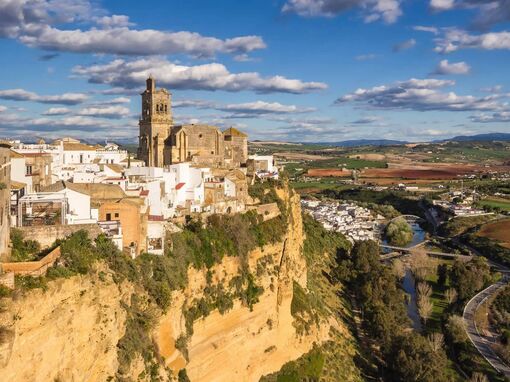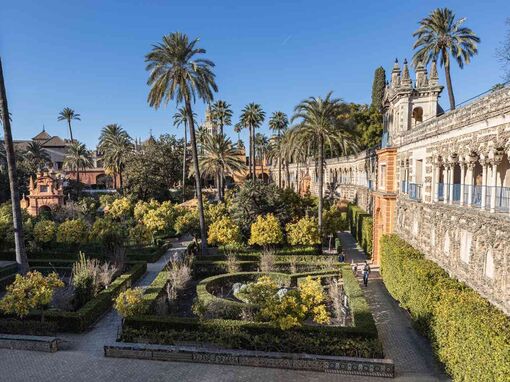Nicole & Justin
Nicole & Justin
Things to Do

Iglesia Parroquial de Santa María de la Asunción
Basilica Menor de santa maria de la asunción - This Gothic-cum-baroque creation is one of Andalucía's more beautiful and intriguing small churches, built over several centuries on the site of a mosque. Check out the ornate gold-leaf altarpiece (a miniature of the one in Seville cathedral) carved between 1580 and 1608, a striking painting of San Cristóbal (St Christopher), a 14th-century mural uncovered in the 1970s, an ornate wood-carved choir and the lovely Isabelline ceiling tracery.
Plaza del Cabildo
Lined with fine ancient buildings, Plaza del Cabildo is the centre of the old town, its vertiginous mirador affording exquisite views over the Río Guadalete. The 11th-century, Moorish-built Castillo de los Duques is closed to the public, but its outer walls frame classic Arcos views. On the square's eastern side, the Parador de Arcos de la Frontera is a reconstruction of a 16th-century magistrate's house.
Convento de las Mercedarias
It's not often that buying biscuits feels like going to confession, but step into the vestibule of this ancient convent (if you find it open), push a bell, and a concealed nun on the other side of a wooden partition will invite you to buy a bag of sweet treats (€3 to €7.50). Place your money in a revolving compartment, and within a couple of minutes it will flip back around with your order on it.
Mirador
Plaza del Cabildo is the centre of the old town. Close your eyes to the modern car park and focus instead on the fine surrounding buildings (all old) and the vertiginous mirador with exquisite views over the Río Guadalete.
Iglesia de San Pedro
A Gothic-baroque confection, sporting what is perhaps one of Andalucía's most magnificent small-church interiors.
Castillo de los Duques
The 11th-century Castillo de los Duques is firmly closed to the public, but its outer walls frame classic Arcos views.
Things to Do Andalucia

Beautiful places to visit in Andalucia
Andalusia, a rocky, sun-baked region on Spain's southern coast, embodies much of what the world thinks of as Spanish: flamenco, tapas, matadors and bullfights. Yet it was under Moorish rule from the 8th-15th centuries, a legacy that shows in its architecture, including such landmarks as the Alcázar castle in Seville, the capital city, as well as Córdoba's Mezquita Mosque-Cathedral and Granada's Alhambra palace.
Granada
Granada, in the foothills of the Sierra Nevada mountains in Andalucía, has many important examples of medieval architecture dating to the Moorish occupation of Spain. Granada is home to the Alhambra, a breathtaking palace that is the most outstanding reminder of Granada's Arab period. Granada's Arab heritage can be seen when walking through the narrow and winding cobblestone streets. The city has a vibrant nightlife: there are many pubs, cafés, clubs and more. One of Granada's specialties is free tapas - Spanish snacks - offered with a drink.
Granada is ideally located between the mountains of the Sierra Nevada (home to the highest point in Spain with a peak of 3479m) and the beaches of the Costa Tropical. Both are only a stone´s throw away from Granada, so within an hour you could be walking along the footpaths of the Sierra or sunbathing on the beach.
Seville
Seville is the capital of southern Spain's Andalusia region and a hotbed for flamenco dance, especially in the Triana neighborhood. The city is known for its ornate Alcázar castle complex, built during the Moorish Almohad dynasty, and its 18th-century Plaza de Toros de la Real Maestranza bullring. The massive Gothic cathedral is the site of Christopher Columbus's tomb and a famous minaret turned belltower, the Giralda.
Situated on the banks of the Guadalquivir River, Seville has a rich Moorish heritage, and used to be a prosperous port that carried out trade with the Americas.
The streets and squares in the historic quarter of the capital of Andalusia are lively and busy. They treasure many constructions that have the World Heritage designation, and many districts are full of traditional culture, like Triana and La Macarena. It's a contagiously romantic city whose celebratory ambiance pervades Seville's winding streets and spills out of the bars and tapas parlors of Santa Cruz and Plaza Alfalfa. Make sure to climb the Giralda tower for a spectacular view of the city.
Jerez
Southwest of Seville, Jerez is a well-heeled place. It's the home of the Royal Andalusian School of Equestrian Art and its famous dancing horses; if you're on a budget or can't be there for a formal performance, it's worth dropping in to catch a morning training session. The other major reason to visit Jerez is to sample its most famous product—sherry. You can do this at a number of bodegas associated with the world's best-known brands, including Bodegas Tio Pepe, The House of Sandeman, Jerez, and Pedro Domecq. They'll soon have you knowing your amontillado from your oloroso. There's also an Alcázar, dating back to the time of the Almohads, which features a small mosque, now the chapel of Santa María Real.
Córdoba
Córdoba is ideal for those who like to eat well, explore on foot, dive into old bodegas and relish architectural wonders. The city's heart needs no introduction, for its fame is widespread: the magnificent Mezquita, a symbol of worldly and sophisticated Islamic culture, lords over the town centre and pulls thousands of tourists into its arched interior every day. The streets of the Judería (Jewish quarter) stretch out from the great mosque like capillaries (albeit those nearest the monument are clogged with tourist bric-a-brac), unexpectedly emerging on peaceful plazas. The compact town centre has a more boisterous vibe with some excellent bars and restaurants – some of which have become sights in themselves – while the Islamic ruin of Medinat al-Zahra, west of town, stirs the imagination with its glory and grandeur.
Córdoba is quiet and withdrawn during the winter months but bursts into life from mid-April to mid-June, when the city stages most of its major fiestas. At this time of year the skies are blue, the heat is tolerable and the city's many trees and courtyards drip with foliage and blooms.
Ronda
Perched on an inland plateau riven by the 100m fissure of El Tajo gorge, Ronda is Málaga province's most spectacular town. It has a superbly dramatic location, and owes its name ('surrounded' by mountains), to the encircling Serranía de Ronda.
Established in the 9th century BC, Ronda is also one of Spain's oldest towns. Its existing old town, La Ciudad (the City), largely dates back to Islamic times, when it was an important cultural centre filled with mosques and palaces. Its wealth as a trading depot made it an attractive prospect for bandits and profiteers and the town has a colourful and romantic past in Spanish folklore.
Ronda was a favourite with the Romantics of the late 19th century, and has attracted an array of international artists and writers, such as David Wilkie, Alexandre Dumas, Rainer Maria Rilke, Ernest Hemingway and Orson Welles.
Ronda's most striking feature is the Puente Nuevo, which spans a gorge over 300 feet deep. Can you guess when the "new bridge" was built? 1793. That should give visitors an idea of how unchanged Ronda has been over the years. It's also known as the birthplace of modern bullfighting. The town's bullfighting ring is only used once a year, at the Feria Goyesca, but it's also a museum where you can learn about the history of this traditional (yet controversial) sport.
Cabo de Gata, Almería
Cabo de Gata–Nijar Natural Park, is nestled in the wild south-eastern corner of Spain, in the province of Almeria, and is one of the last relatively unspoiled stretches along the Mediterranean. It is a mesmerizing and captivating arid landscape of perfect half-moon bays, hidden coves, ruined castles, dizzying cliffs, extensive coral reefs, volcanic rock formations, and spectacular flora and fauna.
It hides away some of Andalucias most amazing beaches, offering unspoilt locations in which to relax and enjoy the quality of the water and the abundance of sea life.
Conil de la Frontera, Cadiz
Conil de la Frontera is a former fishing village, which has become a popular, low-rise resort. It has good beaches and the streets still have a village feel to them. The authentic Spanish fishing town of Conil de la Frontera has approximately 16,000 inhabitants and is situated in the province of Cadiz, in the autonomous community of Andalusia.
It's surrounding landscape is very diverse, with its beautiful coastline, old town features, undeveloped open countryside which reach to forests and villages dotted here and there.
The area boasts 16 kilometres of long sandy beaches stretched out along the coastline; long, flat beaches with white sands and small sections of beach with cliffs behind them. A popular beach is that of Playa de El Palmar, a few kilometers to the south of Conil de la Frontera. Nearby you can also visit the wonderful beaches of Los Caños de Meca, Barbates and Zahara de los Atunes.
Cazorla National Park, Jaen
The Cazorla Natural Park, or the Parque Natural de las Sierras de Cazorla, Segura and La Villas, to give its complete name, is Spain's largest national park and the second largest in Europe. Most definitely, one of Spain's best kept secrets. An area of outstanding natural beauty, it was designated a UNESCO biosphere reserve in 1983 and created a natural park in 1989.
Covering a total area of 214,000 hectares of extremely diverse terrain. The park covers almost a fifth of Jaen province. There are vast expanses of pine forests, river valleys, deep canyons, spectacular waterfalls, rivers, reservoirs and lakes. The sources of the Segura and the mighty Guadalquivir river are here. The Guadalquivir eventually flows through the cities of Cordoba and Sevilla before entering the Atlantic at Cadiz. Whereas the Segura eventually leads to the Mediterranean.
Sierra de Aracena, Huelva
In the province of Huelva, to the northwest of Sevilla and close to Spain's border with Portugal, lies La Sierra de Aracena, without doubt one of Spain's most beautiful and unspoiled mountain regions.
It's a land of glorious woodlands and far-reaching views, of soft, rolling hillsides and crystal-clear streams. The hills are thickly wooded with sweet chestnut and cork oak, giving the area a marvellously green and verdant feel.